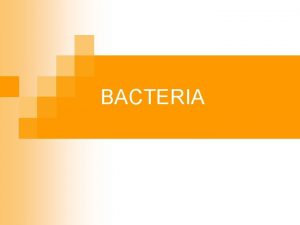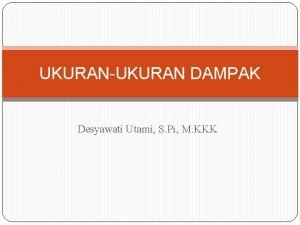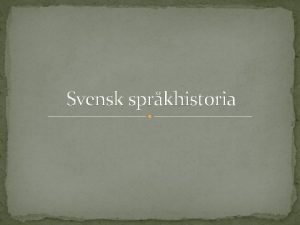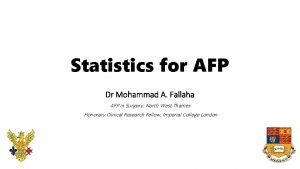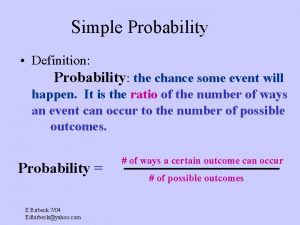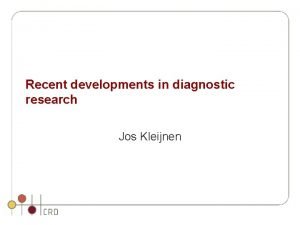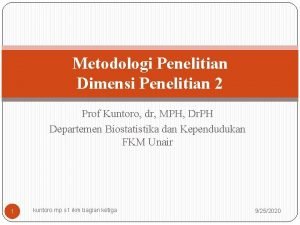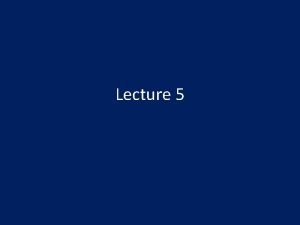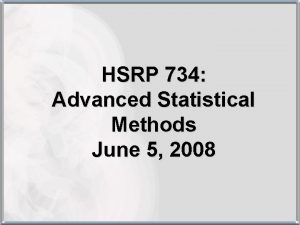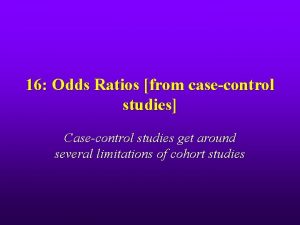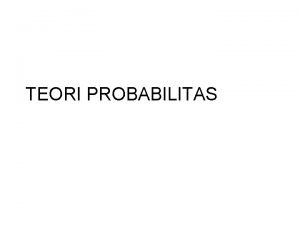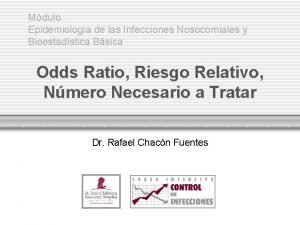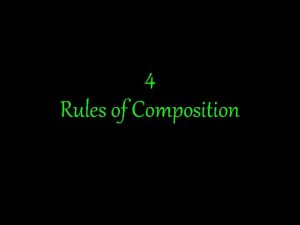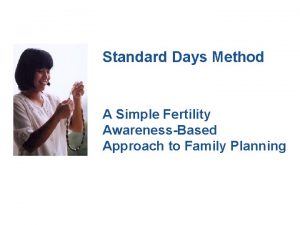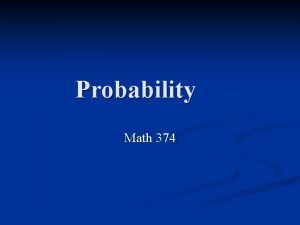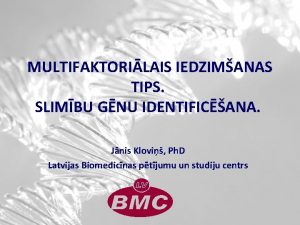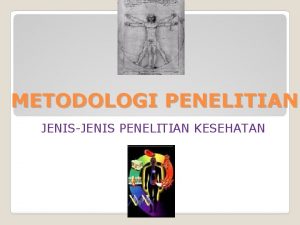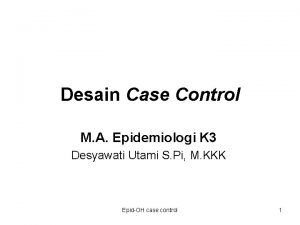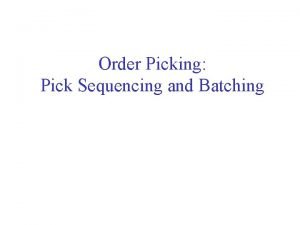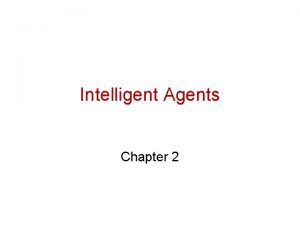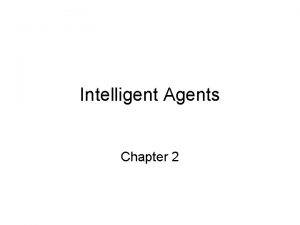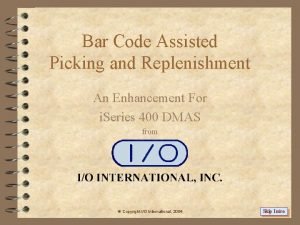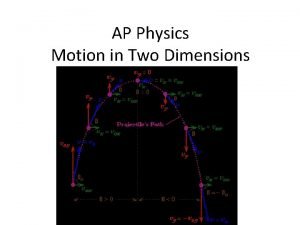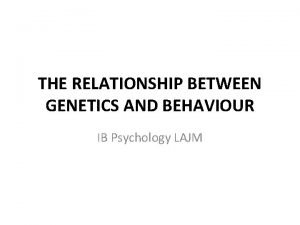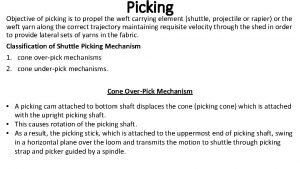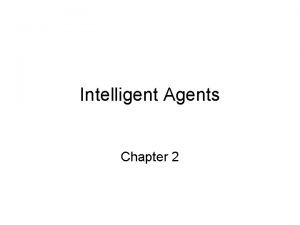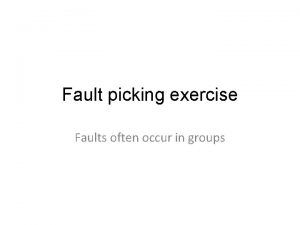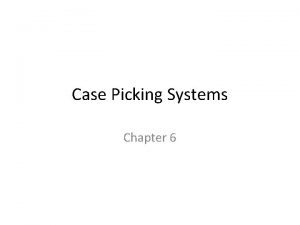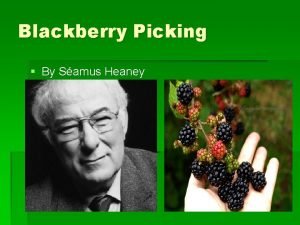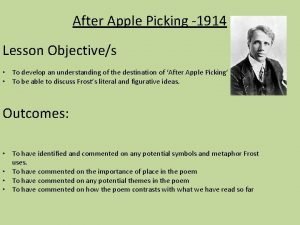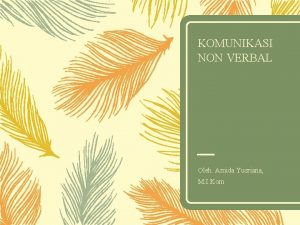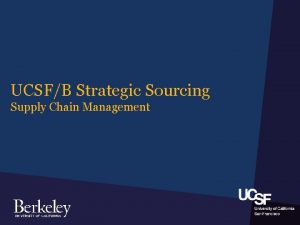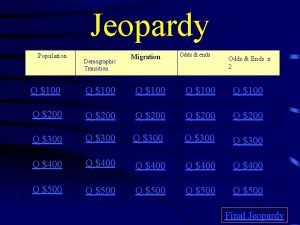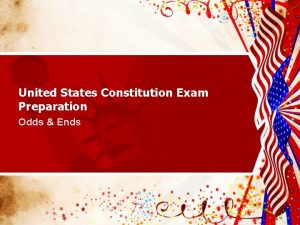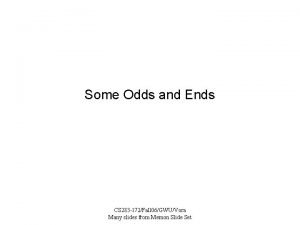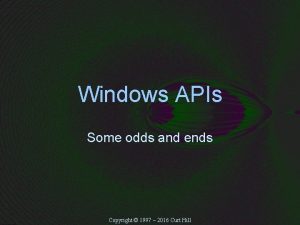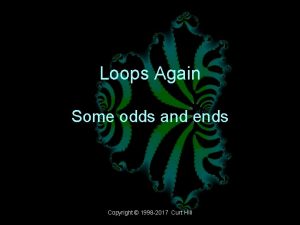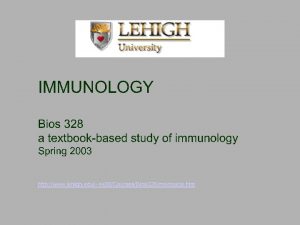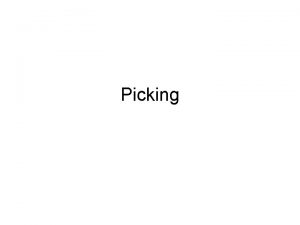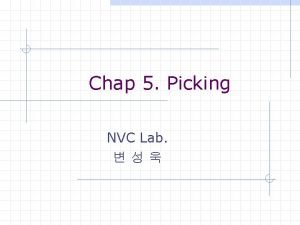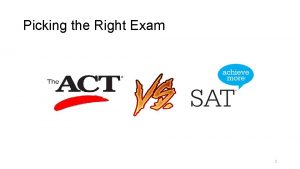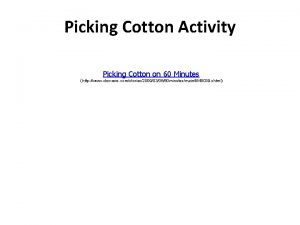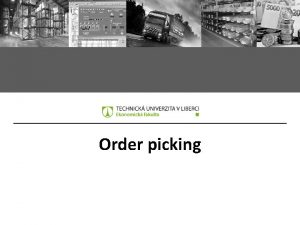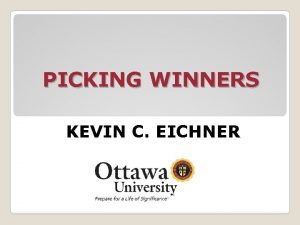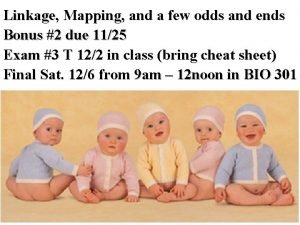Picking up Some Pieces Some odds and ends





















































- Slides: 53

Picking up Some Pieces Some odds and ends of evolution…

Evolutionary Fitness • Technical Definition: the relative contribution an individual makes to the gene pool of the next generation • Stated plainly: How much seed you spread… Q: How does this differ from fitness in a ‘natural selection’ view?

Defining a species • The biological species concept: a species is a population or group of populations whose members have the potential to interbreed with one another in nature to produce a viable offspring and cannot produce viable offspring with other species. • Key words: in nature

Background Review • Biological Species Concept • Barriers preventing species from exchanging genetic information – Pre-zygotic – Post-zygotic

Different ways species can be isolated • Prezygotic barriers: – – – Habitat isolation Behavioral isolation Temporal isolation Mechanical isolation Gametic isolation • Postzygotic barriers: – Reduced hybrid viability – Reduced hybrid fertility • Ex: sterile mules – Hybrid breakdown

Section 16 -3 Concept Map Reproductive Isolation results from Isolating mechanisms which include Behavioral isolation Geographic isolation Temporal isolation produced by Behavioral differences Physical separation Different mating times which result in Independently evolving populations which result in Formation of new species


How do new species come about? • Types of speciation: – Allopatric speciation: due to geography – Sympatric speciation: • Ex: Polyploidy: plants can accidentally double their chromosome number, resulting in a new species Q: What types of geography could lead to allopatric speciation?

Adaptive Radiation • The evolution of a wide range of closely related but distinct species from a common ancestor. – Classic example: darwin’s galapagos finches Q: what are some other examples?






Because of reproductive isolation (ex: sexual selection, where they choose mate with similar beak size) B and C don’t mate Because of ecological competition B and C become more different from each other.

This process can occur many times as long as the ecology can support the different types of birds this results in adaptive radiation.

1. How many different species descended from the species that colonized the first island? Identify them. three; B, C, and D

2. Why is species A no longer present on these islands? How is that change different from what happened to species B? Species A evolved into species B and no longer exists as a separate species. Species B is the common ancestor of species C and D, and it continues to coexist with the two newer species.

• Birds moving to a new island will adapt to the different environment there • If some old birds move back with the old birds – because of reproductive isolation (like behavior – choosing mates with similar beak size) the two birds won’t mate. • Because of ecological competition they will tend to become more different each other so they compete


Adaptive Radiation is an extreme form of divergent evolution


Types of Selection • Stabilizing Selection: – Eliminates the extreme and selects for the ‘average’ • Directional Selection: – Selects for one end of the spectrum • Disruptive Selection: – Selects for both extremes and eliminates the middle Q: Which of these cases was acting in the guppy scenario? Q: Which of these cases would be the explanation for how artifical selection is acting? Q: What type of environment favors each type of selection?


Frequency of Phenotype Section 16 -1 Generic Bell Curve for Polygenic Trait Phenotype (height)

Figure 16– 6 Graph of Directional Selection Section 16 -2 Key Directional Selection Food becomes scarce. If there were drought conditions, the seeds got harder and the beak size got bigger. Low mortality, high fitness High mortality, low fitness

Figure 16– 8 Graph of Disruptive Selection Section 16 -2 Disruptive Selection Low mortality, high fitness High mortality, low fitness Population splits into two subgroups specializing in different seeds. Beak Size Number of Birds in Population Key Number of Birds in Population Largest and smallest seeds become more common. Beak Size

Did you know Animals experience traffic too? No…Seriously. . . They call this a bad bottleneck. We have 1 at Middle Street Merge

Figure 16– 2 Relative Frequencies of Alleles Sectiongenes 16 -1 All the in a population is a GENE POOL Sample Population 48% heterozygous black Frequency of Alleles allele for brown fur 16% homozygous black 36% homozygous brown What is the gene frequency for brown fur? Black fur? What is the sum of all gene frequencies in the gene pool? allele for black fur

Gene Pool • If each frog had two genes for body color- 30 genes will make up the gene pool for 15 frogs • If on frog is red, the 2 out of 30 genes are red for a red gene frequency =. 07. • If there are four purple genes what is the purple gene frequency? • All the gene frequencies add up to what?

Sources of Variation 1. Mutation 2. Sexual Recombination (Gene Shuffling) (name three ways in which genes can recombine in sexual recombination) Natural Selection will cause certain variations to increase or decrease in frequency


Bottle Neck Effect

Genetic Drift a random change in gene frequency Section 16 -2 Descendants Sample of Original Population Founding Population A Founding Population B

Founder’s Effect Colonies start off with different genes Section 16 -2 Sample of Original Population Descendants Founding Population A Founding Population B

Founder’s Effect Colonies end up with different populations Section 16 -2 Sample of Original Population Descendants Founding Population A Founding Population B

REMINDER! • This is a debate among evolutionary biologists about HOW evolution proceeds. • It is NOT a debate about WHETHER evolution proceeds.

5 Conditions of the Hardy. Weinberg Principal AP/IB ONLY! 1. 2. 3. 4. 5. • Random mating Populations must be large No natural selection No mutation No migration If all conditions are met then the gene frequencies stay the same

Analyzing the Gene Pool • One of the tools we use to analyze the changes within a gene pool is the Hardy-Weinberg Theorem (HW) The HW Theroem is a mathematical model that allows for the tracking of allele frequencies through generations within a population.

Hardy Weinberg – WHY? The HW Theorem is a very specific model that describes a population in a nonevolving state. This is to say that it assumes there are no changes over time within the gene pool. When this is the case, the population is said to be at Hardy-Weinberg equilibrium.

Satisfying Hardy-Weinberg • For a gene pool to be ‘non-evolving’ and meet HW Equilibrium, it must satisfy a number of conditions.

Large Population • To have a stable gene pool you need lots of folks. • The effects of genetic drift (random changes in the gene pool due to chance) can be much greater on a small population. • Q: Can you think of an example where this might be the case?

Isolation • No contact (more importantly no gene flow) with other populations. • Other populations may have different frequencies of particular alleles. • Q: An example?

No net mutation • Mutation has the potential to introduce new alleles. • Is mutation really that big a deal? – Not for any one gene, but when you think about ALL genes, its quite a bit of mutation going on… Stat from the boo: 1 mutation/locus/100, 000 gametes – if you have 50, 000 genes, then that’s at least 1 mutation for every two gametes. That’s a lot!

Random Mating • Can’t be picky… Free love needs to rule… • If certain organisms select each other based on certain traits, that means that others will be out of luck and their alleles will be eliminated.

No natural Selection • A free and equal state…of death. • Everyone needs to die and reproduce on equal terms. No one is more likely to reproduce than anyone else.

Some Practice Problems • If 98 out of 200 individuals in a population express the recessive phenotype, what percent of the population would you predict would be heterozygotes?

• If 9% of an African population is born with a severe form of sickle-cell anemia (ss), what percentage of the population will be more resistant to malaria because they are heterozygous(Ss) for the sickle-cell gene?

• This is a classic data set on wing coloration in the scarlet tiger moth (Panaxia dominula). Coloration in this species had been previously shown to behave as a single-locus, two-allele system with incomplete dominance. Data for 1612 individuals are given below: • White-spotted (AA) =1469 Intermediate (Aa) = 138 Little spotting (aa) =5 • Calculate the following frequencies: (¦)A = (¦)a = (¦)AA = (¦)Aa = (¦)aa =

• After graduation, you and 19 friends build a raft, sail to a deserted island, and start a new population, totally isolated from the world. Two of your friends carry (that is, are heterozygous for) the recessive cf allele, which in homozygotes causes cystic fibrosis. • A. Assuming that the frequency of this allele does not change as the population grows, what will be the instance of cystic fibrosis on your island? • B. Cystic fibrous births on the island is how many times greater than the original mainland. The frequency of births on the mainland is. 059%.

• Lets say that brown fur coloring is dominant to gray fur coloring in mice. If you have 168 brown mice in a population of 200 mice. . . . • What is the predicted frequency of heterozygotes? • What is the predicted frequency of homozygous dominant? • What is the predicted frequency of homozygous recessive?

• In humans, the allele that causes the big toe of the foot to be slightly shorter than the second toe is a dominant allele. Some have a big toe that is longer than the second toe, though this is a recessive trait (tt). Determine the allele frequencies of TT, Tt, and tt within this class. • Also determine the frequencies of the T allele and t allele.

That’s all for the unit… My Brain is full…
 What kingdom is considered the ods and ends kingdom?
What kingdom is considered the ods and ends kingdom? Scoring in netball odd and even
Scoring in netball odd and even Nn
Nn Receiving and putaway principles
Receiving and putaway principles Attributable risk rumus
Attributable risk rumus Risiko relatif dan odds ratio
Risiko relatif dan odds ratio Tula lit raisa stain
Tula lit raisa stain Dr fallaha
Dr fallaha Probability definition simple
Probability definition simple Diagnostic odds ratio
Diagnostic odds ratio Metode kualitatif dan kuantitatif
Metode kualitatif dan kuantitatif Odds ratio interprétation
Odds ratio interprétation Odds ratio interprétation
Odds ratio interprétation Odds ratio interprétation
Odds ratio interprétation Haskell odd
Haskell odd Contoh soal probabilitas pendekatan relatif
Contoh soal probabilitas pendekatan relatif Riesgo relativo
Riesgo relativo Tipos de estudo epidemiológico
Tipos de estudo epidemiológico Calcular odds ratio
Calcular odds ratio Rule of thirda
Rule of thirda Haskell odds
Haskell odds The standard days method
The standard days method Nna odds
Nna odds Slimbu
Slimbu Medical research types
Medical research types Tft dice odds
Tft dice odds Unit 9: lesson 1 - fast start
Unit 9: lesson 1 - fast start Crude odds ratio
Crude odds ratio Case control adalah
Case control adalah St george hanover square workhouse
St george hanover square workhouse Litter picking contracts
Litter picking contracts Pick sequence
Pick sequence Shallow screening of ballast in railway
Shallow screening of ballast in railway Peas description for interactive english tutor
Peas description for interactive english tutor Peas description for part-picking robot
Peas description for part-picking robot Assisted picking
Assisted picking Bert is standing on a ladder picking apples
Bert is standing on a ladder picking apples Genetic similarities ib psychology
Genetic similarities ib psychology What is sley eccentricity
What is sley eccentricity Part picking robot peas
Part picking robot peas Cherry picking
Cherry picking What is the faults of picking
What is the faults of picking Discrete picking
Discrete picking Bulk picking in warehouse
Bulk picking in warehouse Layer picking system
Layer picking system Blackberry picking questions
Blackberry picking questions Rat grey fungus
Rat grey fungus After apple picking introduction
After apple picking introduction Tools tackles
Tools tackles Gerakan tangan cherry picking
Gerakan tangan cherry picking Strawberry picking glasgow airport
Strawberry picking glasgow airport Ucsf scm
Ucsf scm Picking yourself up by your bootstraps
Picking yourself up by your bootstraps Agent in artificial intelligence
Agent in artificial intelligence


